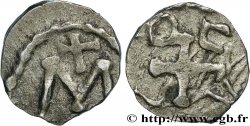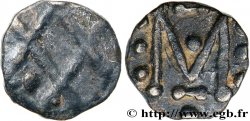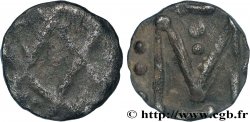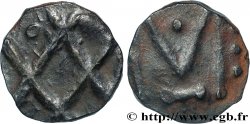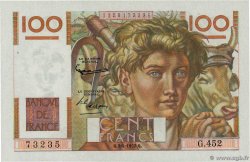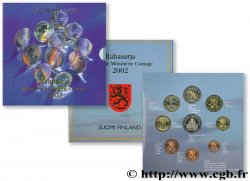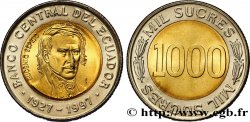bmv_472349 - MONETE DELLO MEROVINGI - MARSEILLES (MASSILIA) Denier, patrice Metranus (?)
non disponibile.
Articolo venduto sul nostro negozio (2018)
Prezzo : 400.00 €
Articolo venduto sul nostro negozio (2018)
Prezzo : 400.00 €
Tipo : Denier, patrice Metranus (?)
Data: c. 716-732
Nome della officina / città: Marseille (13)
Metallo : argento
Diametro : 11,5 mm
Asse di coniazione : 12 h.
Peso : 1,03 g.
Grado di rarità : R2
Commenti sullo stato di conservazione:
Très bel exemplaire, légèrement décentré au droit mais particulièrement complet au revers. Épaisse patine gris foncé
N° nelle opere di riferimento :
Pedigree :
Cet exemplaire provient de la collection Raymond D. (1948-2017), il a été acquis à Bruxelles en juillet 1988 (1.500 fr)
Diritto
Titolatura diritto : M EN PLEIN CHAMP.
Descrittivo diritto : surmonté d'une croisette au-dessus et de deux besants au-dessous ; dans un grènetis.
Rovescio
Descrittivo rovescio : Croix aux extrémités bouletées et cantonnée des lettres OCAS.
Commento
La plupart des exemplaires publiés sont incomplets ou mal frappés. L’exemplaire qui correspond le mieux au nôtre est le n° 35 de la publication du trésor de Cimiez. Notre denier, normalement anonyme, pourrait néanmoins être attribué au patrice Metranus (c.720).
Pour Jean Lafaurie, la fabrication des monnaies d'argent commence vers 675, date de l'assassinat de Childéric II. Ces fabrications continuent jusqu'à l'avènement de Pépin le Bref en 751. La plupart de ces monnaies nous sont connues grâce à l'inventaire de Morel-Fatio du Trésor de Nice-Cimiez et à la publication de Chabouillet en 1890. Le trésor qui fut découvert en 1851 contenait 2.294 deniers d'argent dont 1.500 pièces de Marseille d'après Grierson. Le trésor aurait été enfoui entre 730 et 740.
Selon Wikipédia, Metranus “n’est mentionné que dans un protocole rédigé à Digne en 780 contenu dans le cartulaire de Saint-Victor et sur des deniers d’argent, connus pour la plupart grâce au trésor de Nice-Cimiez découvert en 1851. Le protocole nous indique une liste de cinq patrices provençaux : Ansedertus, Nemfidius, Antenor, Metranus et Abbon. Metranus aurait ainsi succédé à Antenor dont on sait qu’il s’est opposé autour des années 714-716 à Pépin de Herstal puis à Charles Martel, et aurait précédé le patrice Abbon, nommé patrice au plus tôt en 732 et décédé probablement en 739 date de son testament”.
Most published copies are incomplete or poorly struck. The copy that best matches ours is No. 35 of the publication of the Cimiez treasure.. Our denarius, normally anonymous, could nevertheless be attributed to the patrician Metranus (c. 720).
According to Jean Lafaurie, the production of silver coins began around 675, the date of the assassination of Childeric II.. These productions continued until the accession of Pepin the Short in 751. Most of these coins are known to us thanks to Morel-Fatio's inventory of the Nice-Cimiez Treasury and Chabouillet's publication in 1890. The treasure that was discovered in 1851 contained 2. 294 silver denarii including 1. 500 pieces from Marseille after Grierson. The treasure is said to have been buried between 730 and 740.
According to Wikipedia, Metranus “is only mentioned in a protocol written in Digne in 780 contained in the cartulary of Saint-Victor and on silver coins, known for the most part thanks to the Nice-Cimiez treasure discovered in 1851. The protocol gives us a list of five Provençal patricians: Ansedertus, Nemfidius, Antenor, Metranus and Abbon. Metranus would thus have succeeded Antenor, who is known to have opposed Pepin of Herstal and then Charles Martel around 714-716, and would have preceded the patrician Abbon, named patrician at the earliest in 732 and probably deceased in 739, the date of his will.
Pour Jean Lafaurie, la fabrication des monnaies d'argent commence vers 675, date de l'assassinat de Childéric II. Ces fabrications continuent jusqu'à l'avènement de Pépin le Bref en 751. La plupart de ces monnaies nous sont connues grâce à l'inventaire de Morel-Fatio du Trésor de Nice-Cimiez et à la publication de Chabouillet en 1890. Le trésor qui fut découvert en 1851 contenait 2.294 deniers d'argent dont 1.500 pièces de Marseille d'après Grierson. Le trésor aurait été enfoui entre 730 et 740.
Selon Wikipédia, Metranus “n’est mentionné que dans un protocole rédigé à Digne en 780 contenu dans le cartulaire de Saint-Victor et sur des deniers d’argent, connus pour la plupart grâce au trésor de Nice-Cimiez découvert en 1851. Le protocole nous indique une liste de cinq patrices provençaux : Ansedertus, Nemfidius, Antenor, Metranus et Abbon. Metranus aurait ainsi succédé à Antenor dont on sait qu’il s’est opposé autour des années 714-716 à Pépin de Herstal puis à Charles Martel, et aurait précédé le patrice Abbon, nommé patrice au plus tôt en 732 et décédé probablement en 739 date de son testament”.
Most published copies are incomplete or poorly struck. The copy that best matches ours is No. 35 of the publication of the Cimiez treasure.. Our denarius, normally anonymous, could nevertheless be attributed to the patrician Metranus (c. 720).
According to Jean Lafaurie, the production of silver coins began around 675, the date of the assassination of Childeric II.. These productions continued until the accession of Pepin the Short in 751. Most of these coins are known to us thanks to Morel-Fatio's inventory of the Nice-Cimiez Treasury and Chabouillet's publication in 1890. The treasure that was discovered in 1851 contained 2. 294 silver denarii including 1. 500 pieces from Marseille after Grierson. The treasure is said to have been buried between 730 and 740.
According to Wikipedia, Metranus “is only mentioned in a protocol written in Digne in 780 contained in the cartulary of Saint-Victor and on silver coins, known for the most part thanks to the Nice-Cimiez treasure discovered in 1851. The protocol gives us a list of five Provençal patricians: Ansedertus, Nemfidius, Antenor, Metranus and Abbon. Metranus would thus have succeeded Antenor, who is known to have opposed Pepin of Herstal and then Charles Martel around 714-716, and would have preceded the patrician Abbon, named patrician at the earliest in 732 and probably deceased in 739, the date of his will.








 Segnalare un errore
Segnalare un errore Stampate la pagina
Stampate la pagina Condividi mia selezione
Condividi mia selezione Fai una domanda
Fai una domanda Consegnare / vendere
Consegnare / vendere
 Descrittivo
Descrittivo